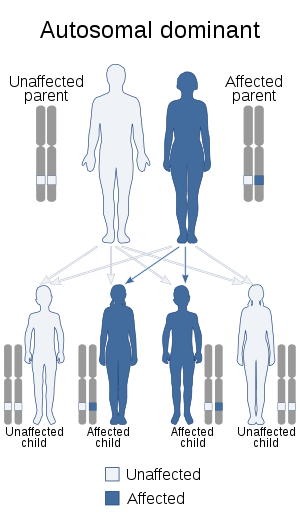MOMO syndrome
MOMO syndrome is an extremely rare genetic disorder which belongs to the overgrowth syndromes and has been diagnosed in only seven cases around the world, and occurs in 1 in 100 million births. The name is an acronym of the four primary aspects of the disorder: Macrosomia (excessive birth weight), Obesity, Macrocephaly (excessive head size) and Ocular abnormalities. It is unknown if it is a life-limiting condition. MOMO syndrome was first diagnosed in 1993[1] by Professor Célia Priszkulnik Koiffmann, a Brazilian researcher in the Genetic and Clinical Studies of neurodevelopmental disorders.
| MOMO syndrome | |
|---|---|
| Other names | Macrosomia-obesity-macrocephaly-ocular abnormalities syndrome, Macrocephaly-obesity-mental disability-ocular abnormalities syndrome |
 | |
| MOMO syndrome is inherited in an autosomal dominant pattern. | |
| Specialty | Genetics |
This syndrome's acronym is an intended pun. It refers to the traditionally tall and obese king of Carnivals, Momus—Rei Momo in Portuguese.
Signs and symptoms
Along with the four aspects of the disorder that give it its name, there are also other common symptoms:
- A downward slant of the forehead
- Delayed bone maturation
- Mental retardation
The ocular abnormalities are generally retinal coloboma and nystagmus.
Pathophysiology
Because MOMO is such a rare disorder, very few studies have been conducted into its causes. Current research suggests that it is linked to a de novo (new) autosomal dominant mutation.[2]
Diagnosis
History
Archie Thompson was born in 2002 in Icklesham, England and weighed 8 lb 4 oz (3740 g). By 15 months his weight had increased to 4 stone (56 lb; 25 kg) and by 24 months it was up to 6 stone (84 pounds; 38 kg). The condition placed a large strain on his heart and lungs. The Thompson family were featured in a documentary for Five first shown on 3 October 2004. It has since aired on Discovery Fit & Health in the United States.
Danielle Falan, from São Paulo, Brazil, is one of the oldest surviving sufferers of MOMO syndrome. At age 17 she was featured in the Archie Thompson documentary as her mother traveled to visit her in Brazil. Falan attended school as normal, and hopes to attend college.
Six other cases have been diagnosed, in Italy,[3] in Brazil , two in Germany, , in Cuba, 2018 Diorkeblin Hernández Durruthy , and in Poland.[4] An additional case was reported in 2010.[5]
References
- Moretti-Ferreira D, Koiffmann CP, Listik M, Setian N, Wajntal A (1993). "Macrosomia, obesity, macrocephaly and ocular abnormalities (MOMO syndrome) in two unrelated patients: delineation of a newly recognized overgrowth syndrome". Am J Med Genet. 46 (5): 555–8. doi:10.1002/ajmg.1320460519. PMID 8322820.
- Moretti-Ferreira D, Koiffmann CP, Listik M, Setian N, Wajntal A (June 1993). "Macrosomia, obesity, macrocephaly and ocular abnormalities (MOMO syndrome) in two unrelated patients: delineation of a newly recognized overgrowth syndrome". Am. J. Med. Genet. 46 (5): 555–8. doi:10.1002/ajmg.1320460519. PMID 8322820.
- Zannolli R, Mostardini R, Hadjistilianou T, Rosi A, Berardi R, Morgese G (2000). "MOMO syndrome: a possible third case". Clin Dysmorphol. 9 (4): 281–4. doi:10.1097/00019605-200009040-00010. PMID 11045586.
- "EWA - Autografy dla Ewy" [EWA - Autographs for Eve] (in Polish). Poland: Group Onet.pl SA. Archived from the original on 13 March 2012. Retrieved 17 December 2011.
- Wallerstein R, Sugalski RD (January 2010). "A new case of MOMO syndrome". Clin. Dysmorphol. 19 (1): 1–4. doi:10.1097/MCD.0b013e32831552a8. PMID 19996736.
External links
| Classification | |
|---|---|
| External resources |